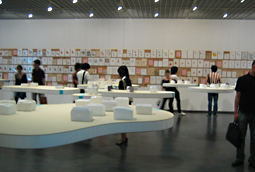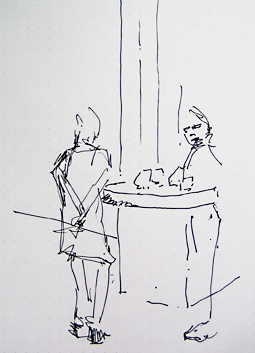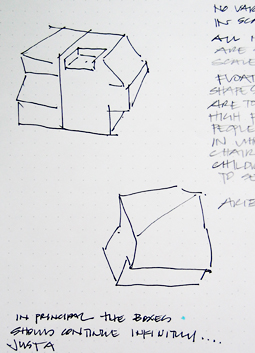 |
|
 |
| Visitors at Architectural Creation wander among the floating islands. |
|
A woman scrutinizing Märkli's drawings. |
Rarely would an architect admit to groping.
Meaning to feel about blindly or uncertainly, to feel one's way, "to grope" is synonymous with "to fish," "to fumble." But there it is in the curator's statement for Architectural Creation: "The aim of this exhibition is to confirm how architects give form to an idea ... The numerous exhibits are traces of how the architects groped."
Architectural Creation, at the National Museum of Modern Art, Tokyo, features the work of Swiss architect Peter Märkli and Japanese architect Jun Aoki. This exhibition contrasts 244 drawings and a handful of models by Märkli with nearly 100 study models by Aoki. Both architects demonstrate a strong interest in painting and sculpture that informs their work in different ways.
I was among the Saturday afternoon crowd piling in to see the exhibition, which is held in one large room. Märkli's vibrant drawings, displayed on the walls, are loosely grouped by project type. These provide the backdrop for 20 floating "islands" that support Aoki's study models divided into 20 groups and sorted chronologically within each group. This impressive volume represents all of the studies for just one of Aoki's residential projects.
Rather than being bound by strict rules, Märkli's drawings are elevated by parameters established for each series that he produces. Some of the drawings reflect an architectural inspiration, others a more fantastical notion reminiscent of the Austrian artist/architect Friedensreich Hundertwasser. Long staggered rows of timber beams mounted on the walls support the modest-sized drawings. This effective method serves to illustrate how the testing of an idea occurs. Each delicate image is engaging in its own right, but seeing them in a sequence is far more satisfying for the viewer.
Of Jun Aoki, the curator's statement reads: "While valuing the fun and severity of the act of 'creating' itself, he endeavors to provide each building with thorough completeness." Indeed, it hardly gets more thorough than 100 study models for one house.
The visitor is not privy to all of the parameters used to produce these models. Were they created in the same day, the same week, or over the course of several months? The models employ a limited palate: styrofoam, some color and applied paper. They are suspiciously perfect, no glue globs, no second-guessing. I wanted to know how Aoki could completely divorce himself from all that had been learned through creating groups 1-19 so as to allow group 20 to be as fresh and new as the first.
Aoki frequently refers to the "rules" he has predefined as a means of evaluation. Each island includes his commentary for that group, giving life to the maker's inner voice. "In principle, these boxes should continue infinitely [considering] the balance between shape of mass and the severing line..." His own comments are often less constructive, more critical.
Aoki's rules aside, I could hardly keep up with the rules of the museum. Though it was eminently clear that taking photos was verboten, visitors were also told to be quiet, not to bump the floating islands (very difficult due to the crowding) and not to stand in one place too long. I was told that pens are not allowed and that I must use the pencil provided by museum staff to make my notes and sketches. Ah, Japan.
The exhibition design also had its shortcomings: museum staff regularly rushed in to stabilize the islands, an effort that was futile and distracting to visitors, and the works are displayed too high for most children or those in a wheelchair to enjoy.
Märkli and Aoki both demonstrate the ability to produce an incredible number of iterations. Even more impressive is their honed instinct for when to stop and say "Okay, that's it, this one is done." Their work shown together is an uninhibited reflection of the struggle felt in all ateliers, in all creative pursuits. I left wondering how Märkli and Aoki wound up showing their work together. Are they friends, collaborators or just contemporaries? It doesn't matter. The exhibition achieves what it set out to do. It sheds light on the process for two artist-practitioners: their methods of study, their trials, their harsh inner critics -- their groping.
 |
|
 |
| Pausing at Aoki's "Group 2." |
|
Iterations within Aoki's "Group 6."
All images by Nicolai Kruger |
|